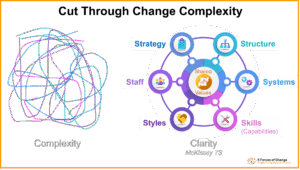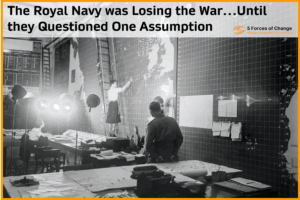
A journey of change does not end when a new IT system is up and running or new structures and processes ‘go live’. The temptation still remains to revert to old habits or to hark back to the ‘good old days.’ So how do we make change anchor change in place…at least until the next change comes along!
My last two blogs have been about helping people to let go of the past – a vital ingredient in successful change. To cap the story off, let’s now look at what can be done to help people to stick with change until it becomes the new norm.
Once a new initiative has been launched, there is a common urge amongst leaders to move onto the next ‘big thing’, assuming that their work is done and that ‘change has happened.’ They are then surprised, weeks or months later, to find that the change has faded away and benefits have diminished or disappeared.
Once an organizational change is deemed to be complete resources are often diverted elsewhere as leadership attention wanes, endangering the change before it has had time to take root.
Here are seven tips for managers on how to anchor change and to sustain it for the long-term:
- Give people something to aim for

Engage your team in setting objectives and plans for the future, based on a long-term vision. After a change, it is essential to refocus people and give them certainty following a period of uncertainty. Working together to create a sense of purpose helps people to look to the future and reduces the desire to dwell on the past.
- Make it ok to have a go and fail, but not ok not to have a go
Ensure people know that change is hard and that performance is likely to get worse before it gets better as they struggle to get to grips with new ways of doing things. Make it ok for people to ‘have a go’ and fail (or perform worse than they used to), safe in the knowledge that they will be given the time to climb the learning curve. At the same time, make It clear that there is no going back, and everyone must ‘have a go’ despite any misgivings.
- Recognize every success
Praise people publicly just for making effort to adopt the change and for every small success. This helps keep people motivated to persevere through teething problems and encouraging others to get on board.
- Identify and fix teething problems

There will always be problems after a change, like bugs in an IT system or loop-holes in a new process. For some people this will be taken as evidence that the change has failed. So it is important to encourage people to report teething problems and to publicise the fact that they have been spotted and fixed, or that there is a clear plan in place to sort them out.
- Keep on coaching
Some lessons cannot be taught in the classroom. Coaching people through early difficulties is crucial in combating any temptation to revert to the tried and trusted methods of the past.
- Build new teams
When change involves re-structuring, then team bonds will inevitably be broken. To minimise the impact this has on team cohesion and motivation, attention should be given to team building – forging new bonds and a new team spirit.
- Change the measures and targets
The old adage ‘what you measure it what you get’ is particularly true following change. Measures and targets must support new expectations. If, for instance, you want people to focus on quality as well as throughput then you had better measure, target and reward quality in the same way as you measure, target and reward throughput.
So, the work doesn’t end with ‘go live.’ On the up-side change provides an opportunity for a fresh start and to move your team on to bigger and better things.








